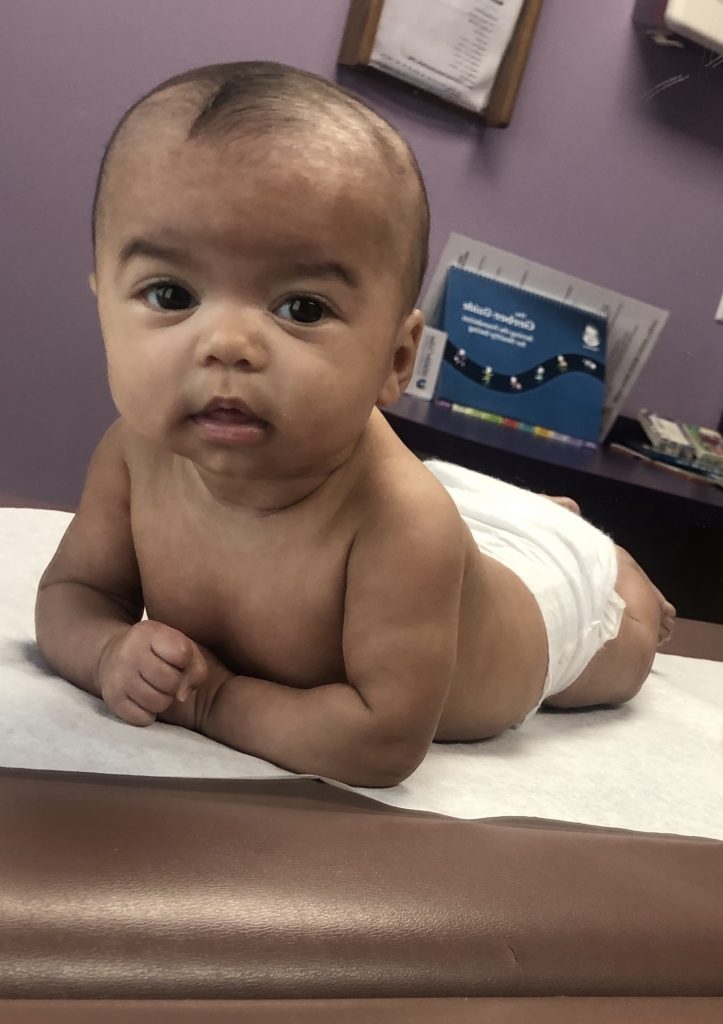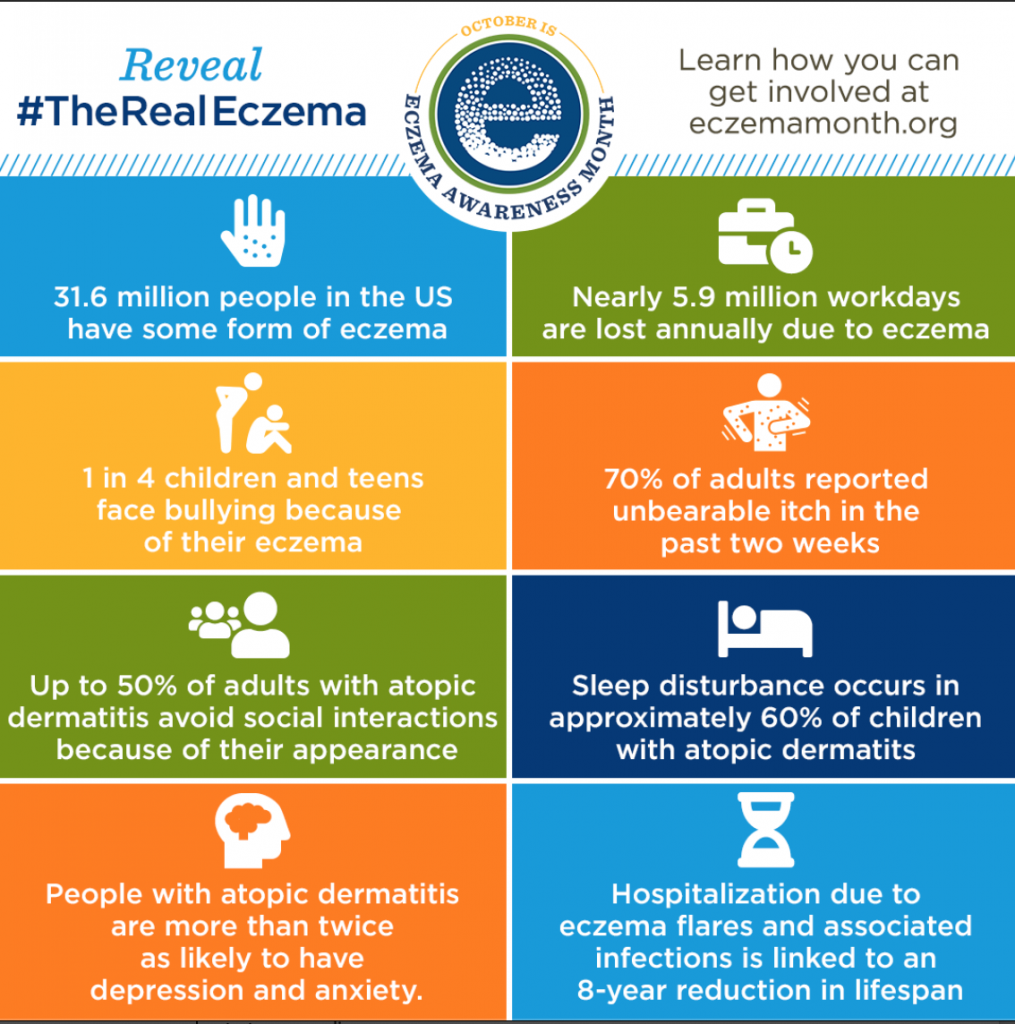I was compensated by Med-IQ through an educational grant from Sanofi Genzyme and Regeneron Pharmaceuticals to write about the signs, symptoms, and treatments available for eczema/atopic dermatitis. All opinions are my own.
Disclaimer: Links to external sites are provided as a convenience and for informational purposes only. They are not intended and should not be construed as legal or medical advice, nor are they endorsements of any organization. Med-IQ bears no responsibility for the accuracy, legality, or content of any external site. Contact the external site for answers to questions regarding its content.
Motherhood is hard. You go from solely taking care of yourself to being entirely in charge of another human being. Literally in charge of all the things. One thing that has always been something that makes me nervous is skin issues, mostly rashes or similar issues. Now that the girls are almost two, I’ve eased up sending pictures to my mom and mother in law daily, asking if this is normal, but, there are still things that I feel lost on and somethings I don’t notice as I should.
Our story with eczema is a two-part story. It started with Emerson, went away and then a few months later showed up on both Emerson and Harper.
When Emerson was just a little babe, she developed pretty severe eczema on top of her head. It was awful. She would itch it to the point where it would bleed—nothing worse than seeing your tiny baby uncomfortable and not really being able to do much about it. At first, I was under the impression that it was cradle cap and there wasn’t too much to do. Just leave it alone is the advice I got. But, I just couldn’t leave it alone. I took her to the doctor, and we found out it was actually eczema. We were told to yes just leave it alone, but also moisturize, attempt to keep her from scratching, and apply topical corticosteroids to help reduce inflammation and symptoms.
Eventually, with time, continuous moisture and topical medicine, we were able to get it under control – even to the point where we no longer saw any signs of it.

A few months later, we took all three girls to the pediatrician for a check-up. The doctor asked me what I was putting on Emerson and Harper for their Eczema. I quickly responded, “Eczema? Oh yeah, uhm, we have a cream. It just gets dry sometimes, but I swear I am paying attention….” I rattled off a few more things to justify why I hadn’t called ahead or brought it up first.
Here and there, I noticed E and H (the identicals of the triplets) would have a little bit of dry skin and, at times, a raised area that felt a bit rough, but I didn’t really notice it until they started itching. Eventually, it started to look like permanent goosebumps, but eczema didn’t cross my mind because it’s not what I had seen on friends previously. When I shared more with the doctor, she confirmed it was Eczema. I felt terrible I hadn’t been more diligent, but fortunately, the girls didn’t seem to be too bothered by it. Since finding out they do have eczema, I will notice them itching their lower back or stomach a bit more often. At times, it seems to go away, but I do notice they have flare-ups. It’s been hard to pinpoint if there is an exact trigger. Luckily, we can keep it under control by moisturizing their skin.
When I am not calling my mom or mother-in-law for help, I tend to go right to Google. It is quick, easy, and usually can get me some sort of answer. However, I learned from speaking with Peter A. Lio, MD that there is a decent amount of misinformation online about eczema and atopic dermatitis. only 1/3 of websites that focus their content on eczema are in agreement with current clinical thinking on this disease.
I chose to work with Med-IQ to help myself and my husband understand more about eczema/atopic dermatitis, specifically its signs, symptoms, and different treatment options. We wanted to educate ourselves on what we should be looking for, as well as what we can do during flare-ups. In choosing to work with them, I was lucky enough to be a part of a discussion led by Peter A. Lio, MD. He is a Clinical Assistant Professor of Dermatology and Pediatrics at Northwestern University Feinberg School of Medicine and the Founding Director of the Chicago Integrative Eczema Center in Chicago, IL.
Did you know Eczema is one of the most common skin conditions children experience?
Fast Facts
- More than 31 million Americans have some form of eczema.
- Around 16.5 million adults in the US have atopic dermatitis, with 6.6 million reporting moderate-to-severe symptoms
- Although atopic dermatitis most commonly develops early in life, it can persist into adulthood for many patients.
- 10% to 25% of children have atopic dermatitis; of which, approximately 1/3 have moderate-to-severe disease
- 5% to 10% of adults have atopic dermatitis (3% of elderly); of which, approximately 1/2 have moderate-to-severe disease
- 80% of individuals affected with AD experience disease onset prior to 6 years of age, and current data suggests at least 80% will “outgrow” their AD by adolescence or adulthood.
- Atopic dermatitis affects all races; however, African-American/black and Hispanic children tend to have more severe AD.
- Atopic dermatitis is most commonly associated with other allergic/atopic conditions such as allergy, asthma, hay fever, and food allergies.
- Atopic dermatitis is also associated with several mental health conditions, including ADHD, anxiety, and depression.

You can find more eczema stats here.
What are eczema and atopic dermatitis?
First, it’s important to know that Eczema is the general name for a group of dermatologic conditions, simply meaning inflammation of the skin. are several types of eczema. The term “eczema” is often used interchangeably with “atopic dermatitis.
The word “eczema” has two meanings. It can mean either of the following:
– A group of conditions that causes inflamed, irritated, and often itchy skin
– Any one of the conditions within this group, such as atopic dermatitis, contact dermatitis, or stasis dermatitis.
American Academy of Dermatology – Eczema Resource Center
Eczema is very common. Over 31 million Americans have some form of eczema. (NationalEczema.org). It is important to note that it is not contagious; you can not “catch it” from someone. Eczema is a red, itchy rash that can happen at any time of year. It is often worse in the winter months, but for some patients, it can worsen in the summer months due to the heat and humidity. More severe cases of atopic eczema can be quite painful and cover large areas of the body.
What causes eczema?
Eczema (Atopic dermatitis) is considered to be a chronic (long-lasting) condition and although the exact cause is unknown, researchers know that a combination of genes and a trigger can be why people develop eczema.
Some people may have specific predisposing genes. Within those genes, a mutation may occur that can cause a loss-of-function of a protein called filaggrin. Patients who don’t make enough filaggrin may have “leaky” skin, which weakens the skin barrier and drives more inflammation. This can make the patient more sensitive to allergens and irritants – eventually leading to atopic dermatitis. As for triggers, it can be several things – a reaction to food or something you touch, such as wool or animals, pollen, certain soaps, fabrics, and lotions.
Eczema Triggers
Quick Reference Sheets from the National Eczema Association
Atopic Dermatitis 101 for Adults
Atopic Dermatitis 101 for Parents
What are the symptoms of eczema?
Just like many things, eczema and its symptoms are different for everyone. It may also change as you get older. Emersons eczema on her scalp looks much different than what she currently has. Eczema is typically pretty itchy and can range from being a mild itch to a more intense itch. When E was tiny, it was itchy to the point of bleeding and now, it seems as if it is more “annoying” and doesn’t bleed or scab. Now, their symptoms seem to flare-up vs. being a constant.
Other symptoms to look for:
- Dry, sensitive skin
- Inflamed, discolored skin
- Rough, leathery or scaly patches of skin
- Oozing or crusting
- Areas of swelling
How does Eczema affect patients and families?
It most commonly occurs in babies and toddlers, but it can also occur in teens and adults. A lot of times, parents are told their child will grow out of it or it will just go away, which isn’t what we want to hear when we are looking for answers. It can be frustrating for parents, but at the same time for the adolescent and/or teen. It is a hopless feeling when you see your child not feeling their best and there isn’t anything you can do to help. Also, with little ones, they aren’t able to tell you how they’re feeling or what “hurts.” You have to hope what you’re doing is helping.
In more severe cases, eczema can have a huge effect on quality of life for both the patient and the patient’s family. It can affect a wide variety of things – from sleep patterns, to the ability to focus in school or at work, to stress levels and mental health. I’ve had friends who suffer from pretty severe eczema in the winter and it is heartbreaking to watch what they go through. Searching high and low for something that can help the pain she feels in her hands. Watching the precautions she has to take to make sure it doesn’t get worse. I have seen her avoid going places where she can’t wear her gloves because she is embarrassed. It hurts my heart to see her limit herself because of her eczema.
Also, there is an economic impact eczema causes for many patients. Over-the-counter medicines and treatments can be costly. I had a co-worker who had pretty severe eczema in her adult life, and the one thing she found that truly worked was expensive. While it worked wonders, there was just no way that she could afford it, leading her to suffer daily.
How to Treat Eczema
While there is no cure, most cases can be controlled with a customized skin care plan, which may include moisturizers, prescription medications, and strategies to eliminate triggers.
What has worked for us:
As I mentioned, the girls eczema is mild in comparison to many. They do have flare ups, which can be controlled with intense moisturizing. In hopes of preventing falre ups, we make sure to always use a gentle cleanser and moisturizer, which helps lock water into the skin. When looking for a cleanser and moisturizers, we try to find products with the National Eczema Association’s Seal of AcceptanceTM on the label.
New research found that preventively moisturizing the skin of babies who are at high risk could help protect their skin barrier. In our discussion, Dr. Lio recommended using gentle oil-based cleansers and selecting moisturizers with no preservatives.
In the next part of this series, I will be chatting more about traditional and new treatments options for people with eczema.
You can find a great deal of information on the American Academy of Dermatology website and National Eczema Association website.
Med-IQ is conducting an anonymous survey and would appreciate your input. The survey will take less than 10 minutes to complete. Survey responses are shared only in aggregate. Your responses to these survey questions will provide Med-IQ with important information about your experiences with atopic dermatitis, which will help us develop future educational initiatives. Once you’ve completed the survey, you will have the option of providing your email address to be entered into a drawing administered by SOMA Strategies to win 1 of 10 $100 VISA gift cards. If you choose to enter, your email address will be used only to randomly draw the winners and notify them of their prize.
You can find the link here.




